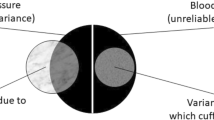Abstract
This is one in a series of statistical guidelines designed to highlight common statistical considerations in behavioral medicine research. The goal is to briefly discuss appropriate ways to analyze and present data in the International Journal of Behavioral Medicine (IJBM). Collectively the series will culminate in a set of basic statistical guidelines to be adopted by IJBM and integrated into the journal’s official Instructions for Authors, and also to serve as an independent resource. If you have ideas for a future topic, please email the Statistical Editor, Suzanne Segerstrom at segerstrom@uky.edu.
Similar content being viewed by others
References
Cohen J. A power primer. Psychol Bull. 1992;112:155–9.
Szucs D, Ioannidis JPA. Empirical assessment of published effect sizes and power in the recent cognitive neuroscience and psychology literature. PLoS Biol. 2017;15:e2000797.
Gelman A, Carlin J. Beyond power calculations: assessing type S (sign) and type M (magnitude) errors. Perspect Psychol Sci. 2014;9:641–51.
Segerstrom SC. Between the error bars: how modern theory, design, and methodology enrich the personality-health tradition. Psychosom Med. 2019;81:408–14.
Simmons JP, Nelson LD, Simonsohn U. False-positive psychology: undisclosed flexibility in data collection and analysis allows presenting anything as significant. Psychol Sci. 2011;22:1359–66.
Hoenig JM, Heisey DM. The abuse of power: the pervasive fallacy of power calculations for data analysis. Am Stat. 2001;55:19–24.
Cumming G. The new statistics: why and how. Psychol Sci. 2014;25:7–29.
Benjamin DJ, Berger JO, Johannesson M, Nosek BA, Wagenmakers EJ, Berk R, et al. Redefine statistical significance. Nat Hum Behav. 2018;2:6–10.
Lakens D, Adolfi FG, Albers CJ, Anvari F, Apps MA, Argamon SE, et al. Justify your alpha. Nat Hum Behav. 2018;2:168–71.
Author information
Authors and Affiliations
Corresponding author
Ethics declarations
This article does not contain any studies with human participants or animals performed by the author, and so there was no requirement for informed consent.
Conflict of Interest
The author declares that there are no conflicts of interest.
Additional information
Publisher’s Note
Springer Nature remains neutral with regard to jurisdictional claims in published maps and institutional affiliations.
Rights and permissions
About this article
Cite this article
Segerstrom, S.C. Statistical Guideline No. 5. Include Results of a Power Analysis; if a Power Analysis Was Not Performed, Describe the Stopping Rule for Recruitment. Int.J. Behav. Med. 27, 140–141 (2020). https://doi.org/10.1007/s12529-020-09868-7
Published:
Issue Date:
DOI: https://doi.org/10.1007/s12529-020-09868-7



